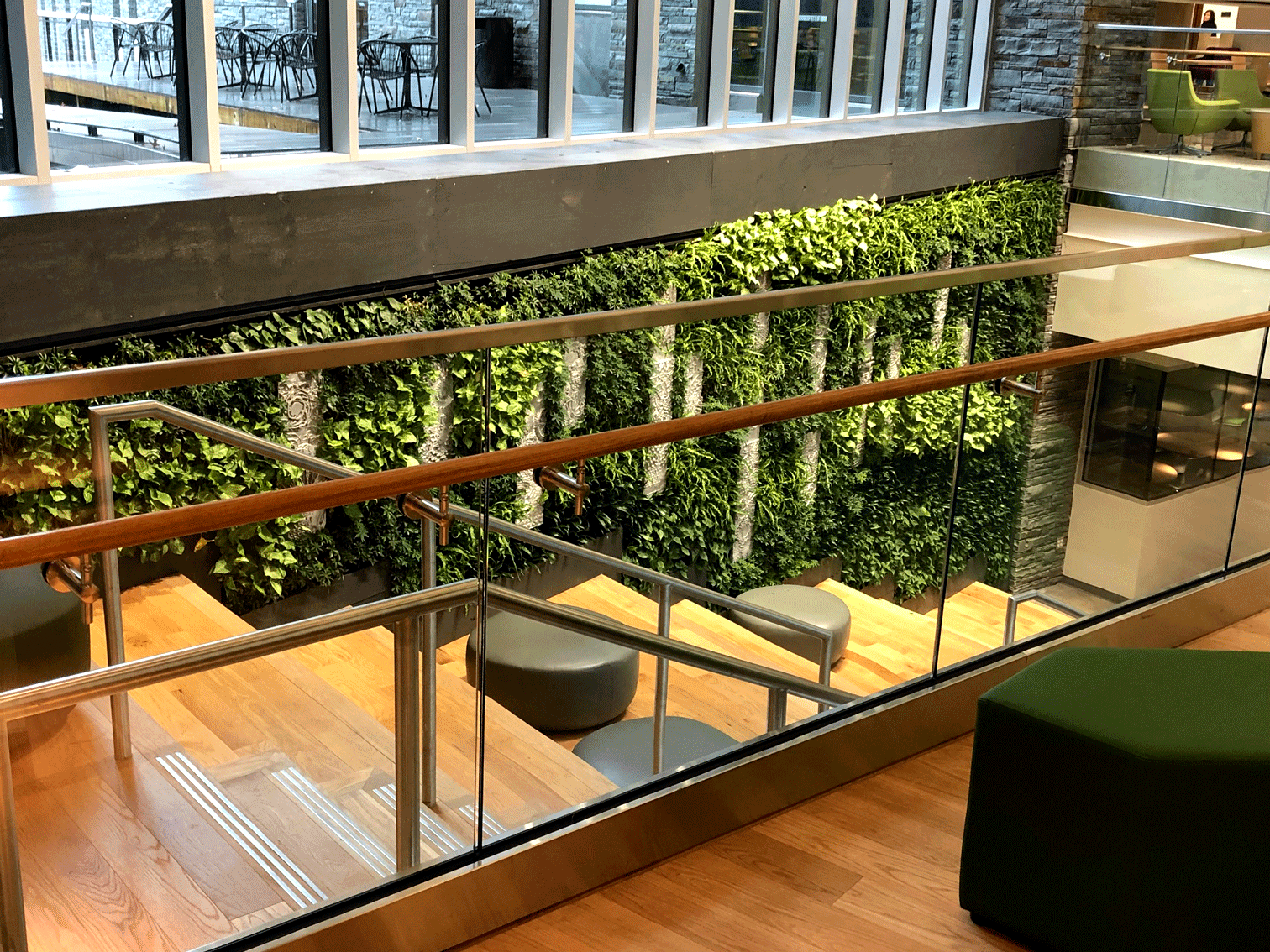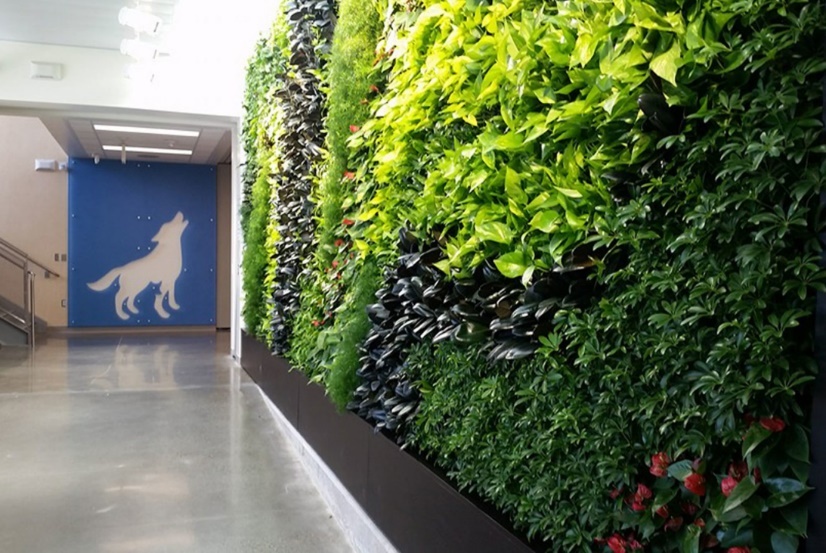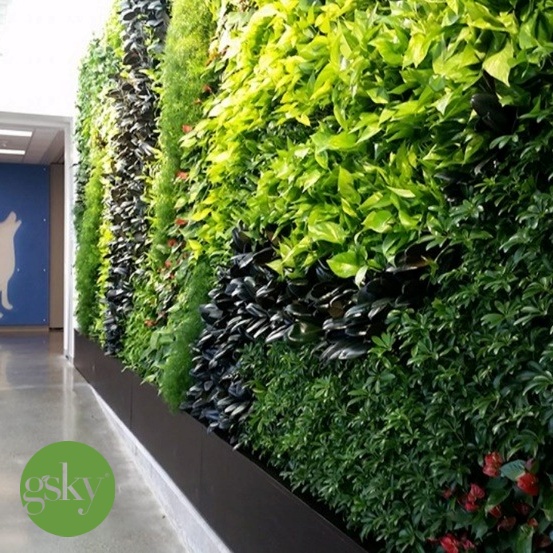Presence of Plants Proven to Improve Test Scores, Learning Opportunities and Attitudes
As educators across the globe look to improve student outcomes – from the elementary to the collegiate level – a new trend is beginning to take root. Equipped with the knowledge that indoor plants improve general health and well-being, living green walls, like those created by GSky Plant Systems, are bringing life to educational spaces.
Greenery Leads to Increased Student Performance
It only takes adventuring into “the great outdoors” to understand the myriad benefits being in nature can do for the mind, body and soul. Your heart rate slows as a sense of relaxation ensues, with the stresses of daily life fading as you breathe in the clean, crisp air.
Studies have shown that bringing that experience indoors can have the same effect, and when applied in schools, can transform test results and improve the overall educational experience for children and teachers alike. One study found that vegetation surrounding schools is associated with improved standardized test scores on math and reading, and another study of 101 public high schools in Michigan found that views of greenery from classroom and cafeteria windows were associated with increased standardized test scores and graduation rates, in addition to decreased criminal behavior.[1]
Further studies indicate that simply being in the presence of plants can increase memory retention by approximately 20 percent and improve performance on tests. “This is thought to be due to the fact that their leaves and stems can absorb, deflect, and retract background noise, such as exterior traffic, children playing in the playground, and people talking in corridors.”[2]

GSky’s Versa Wall® Indoor Living Wall at the new Biomedical Sciences & Engineering (BSE) facility at Universities at Shady Grove.
This fall, to help nurture student learning, GSky® completed the installation of a Versa Wall® for the new Biomedical Sciences & Engineering (BSE) facility at Universities at Shady Grove in Rockville, Maryland. The wall is part of a biophilic plan to bring interior and exterior campus environments into the building atrium, reinforcing the visual connection between the indoor and outdoor environment. “The living wall is meant to almost appear as an extension of the east courtyard exterior environment flowing into the building,” said Christopher Case, Project Engineer for Gilbane Building Company.
Adding to the STEM/STEAM Curricula
As the ever-evolving educational model continues its shift toward a science, technology, engineering, art and math (STEAM) curriculum, educators are looking to more hands-on learning opportunities. Green walls, described as vertical gardens that encompass plants, a growing mechanism and a watering system, provide teachers with a new way to integrate STEAM principles into the curriculum.
“The essence of project-based learning is that the student constructs meaning and knowledge based on direct experience, interacting with their environment.”
Known as project-based learning, this method allows instructors to develop educational opportunities for students to interact with a green wall. Michael McCullough, Michael Martin and Mollika, in their article, “Implementing Green Walls in School,” explain the benefits of project-based learning: “The essence of project-based learning is that the student constructs meaning and knowledge based on direct experience, interacting with their environment.” In turn, students are empowered to use critical thinking to develop strategies for maintaining a green wall, once again bringing them back to the natural world, despite being indoors.
Through project-based learning, green walls also allow students to better understand nature’s role in STEAM fields, all in one place. From plant biology, to the engineered plant container (created using drafting technology), to the geometrical concepts used in the design phase, all the way to the artistic process involved in the structure, each component is critical in creating a functioning end product.[3]

Students at Versa Hazel Wolf K-8 can visit the GSky Versa Wall.
The Hazel Wolf K-8 at Pinehurst School in Seattle, Washington is embracing this teaching strategy and turned to GSky for help bringing a vibrant vertical garden to life. Displayed in the main entrance of the school, students regularly visit a 323 square foot GSky® Versa Wall® for STEM education. As an active teaching tool for students’ science projects, the living wall features a variety of 1,522 plants and embodies Hazel Wolf’s commitment to the community and students.
Increasing Health and Happiness
The benefits of green walls don’t end at better test scores and increased learning opportunities. What could be argued as the most important component of indoor vertical garden is the change plant life has on the mind and body.
Because stress levels often run high in schools, with what can feel like an insurmountable amount of pressure to perform well, green walls naturally act as a catalyst to reduce stress and anxiety. Plus, the addition of greenery in schools decreases carbon dioxide in the atmosphere (as it is absorbed by plants, which then convert it back into oxygen), leading to a reduction in headaches, dizziness and tiredness – all of which contribute to students’ ability to focus.[4]
To increase productivity while beautifying a space, Georgetown University opted for a GSky® Versa Wall® for a student center in one of their residence halls, New South. The 828 square foot vertical garden is filled with 5,000 plants filters and purifies the air, allowing students to breathe easy.
So, no matter one’s location or learning style, GSky’s green walls are proving to be a critical element in creating a positive educational experience for students, big and small.
References:
[1] https://www.frontiersin.org/articles/10.3389/fpsyg.2018.00619/full#B12
[2] https://www.phsgreenleaf.co.uk/the-benefits-of-plants-in-schools-and-educational-facilities/
[3] https://www.frontiersin.org/articles/10.3389/fpsyg.2018.00619/full
[4] https://medium.com/@KaseyLaineRiley/green-walls-in-schools-beyond-health-benefits-and-into-curriculum-3fdf69207204
 Greenroofs.comConnecting the Planet + Living Architecture
Greenroofs.comConnecting the Planet + Living Architecture




George Irwin, MS Adapted Education and Curriculum Writer, Founder GLTI
Installing a green wall is one thing… difficult to correlate the cognitive success without actually providing an authentic experience. “Students can visit the wall” according to GSky, yet provides no real learning opportunity. The subject matter just so happens to be the wheelhouse of the GLTI founder George Irwin a recognized education curriculum writer with formal cognitive and real world skill set that scaffolds authentic learning, rubrics, data collection, etc to support their position. You can’t install a living wall at a school and take credit for improved academic performance, it just does not work that way without years of data collection and controlled studies. Just more fluff for a press release. GLTI is responsible for the education movement long before McCullough, Martin, and Sajady https://www.youtube.com/watch?v=YM_ugzOg2wI&t=90s
Linda Velazquez
George, I believe that the majority of us in the living architecture community would agree that regardless of an associated plant/greenwall student curriculum (STEAM or otherwise), the many physical and biophilic benefits of living, breathing plant material do enhance a learning space. A specialized curriculum would indeed offer an enhanced “real learning opportunity” and we are seeing an increase within educational facilities to incorporate project-based learning, as is stated here. I don’t think anything in this press release claims otherwise or is fluff, and many professionals have been incorporating education along with designed greenwall & greenroof systems for decades.
What Are Vertical Gardens? – Bescord
[…] The 828 square foot vertical garden is filled with 5,000 plants filters and purifies the air, allowing students to breathe easy. via […]
philIP HERR
ITSHOULD BE REQUIRED
CAN THERE BE EDIBLE WALLS